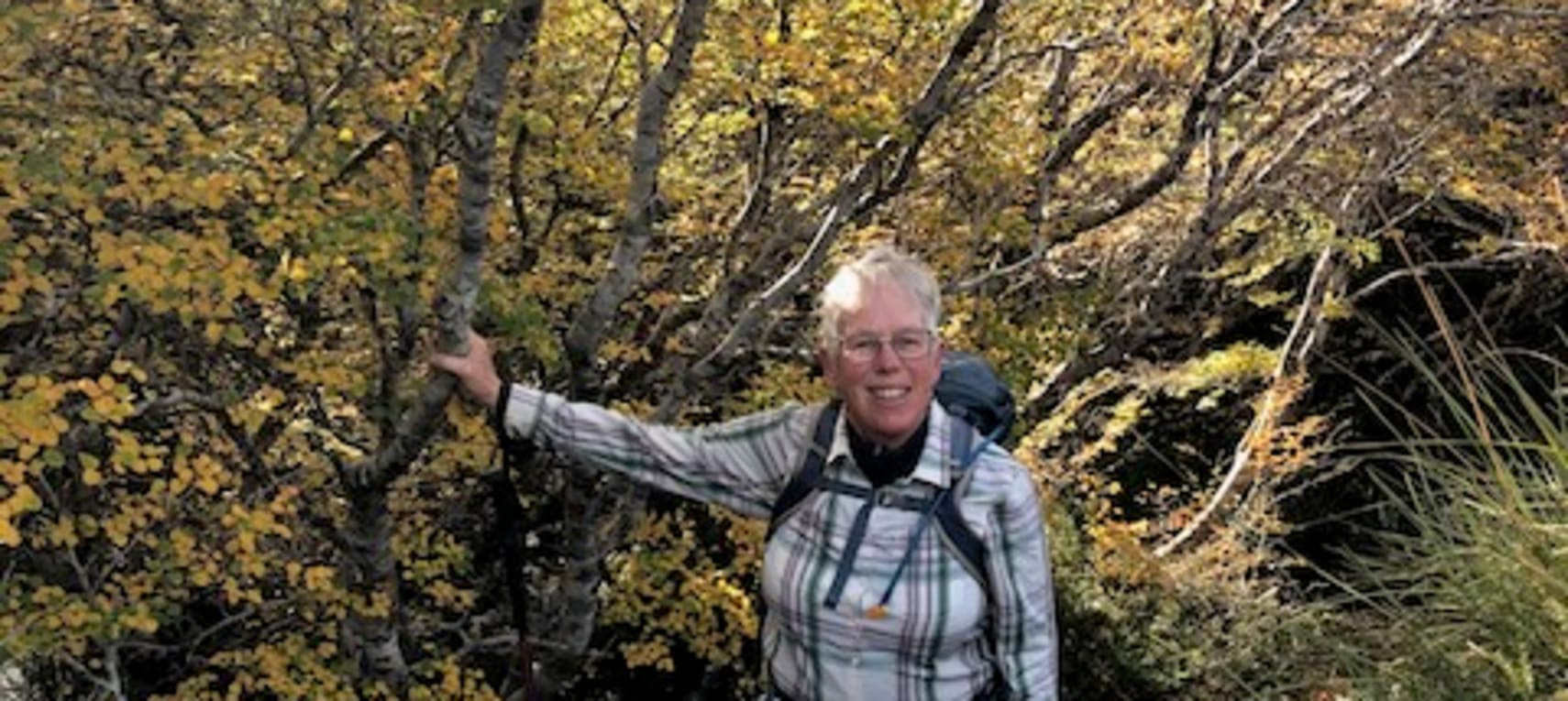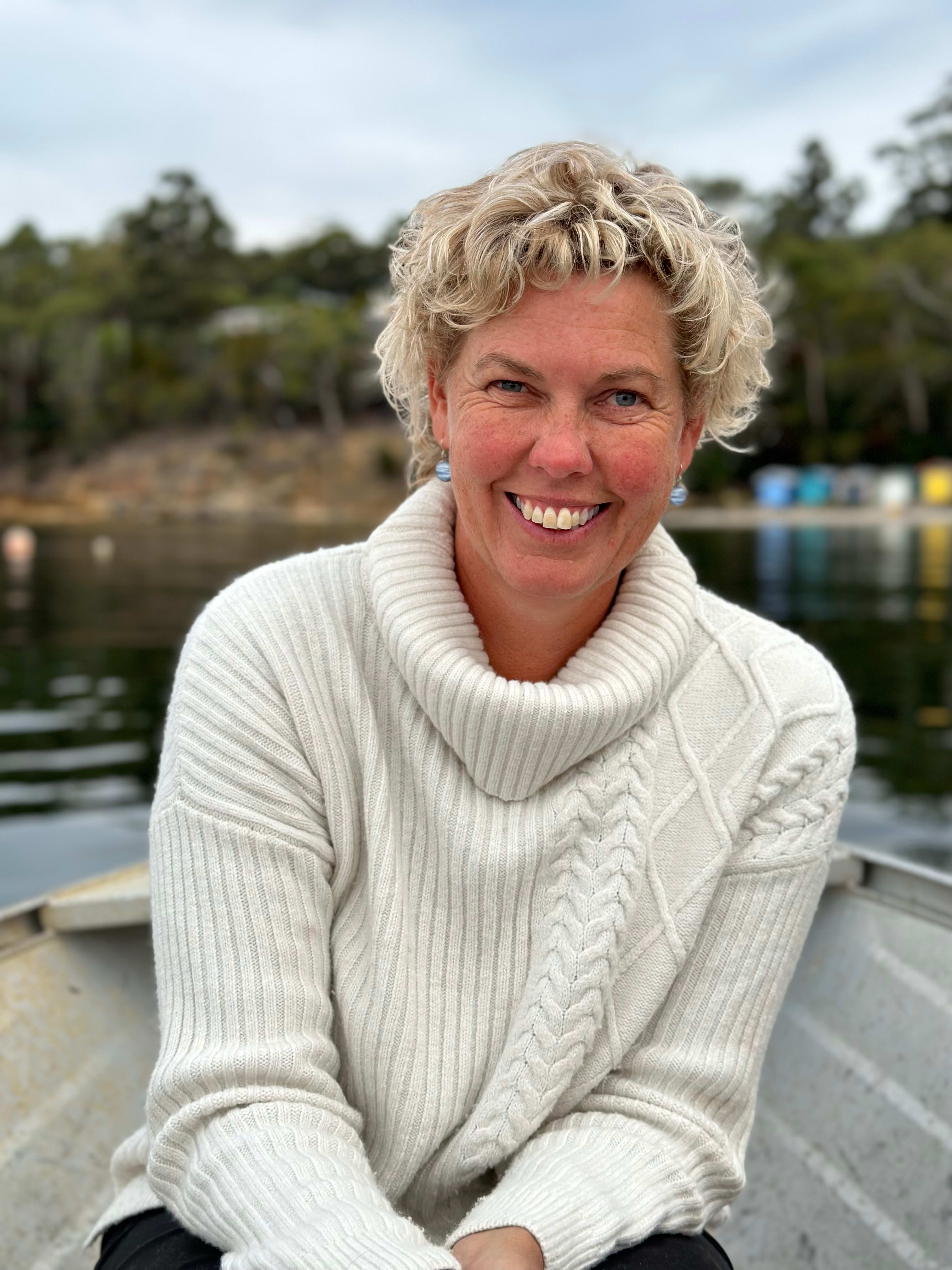T H E N A N D N O W
I should thank it, thank it for the experiences, companionship and insights it had offered, thank it for expanding my horizons, literally and metaphorically, thank it for introducing me to areas I would not have otherwise pursued, like botany. So, speaking out loud, I did and a little wind rustled through the bushes.
writer and photographer CHRISTINE WILSON
I have dim memories of my first visit to the Hartz Mountains National Park. I was 12 and recall visiting lakes Osbourne and Perry, two tarns of glacial origin at the base of the Devils Backbone, a fanged ridge extending north, lightly clad with scrub. I’d been taken up there by my parents and the Bailey family. Am I making this up? There’s no one now left to ask. Memories persist, but they also slide, merge and vanish. We slogged out to the nearest lake, very close to the second one, which was inaccessible. The path was muddy and puddled. Low bushes loomed over its edges with their bright pink, red and white berries, forming the understorey to a forest of snow gums.
We reached the rocky edge of the lake with its border of boulders. The Devils Backbone was invisible under a cloak of thick mist. Drops pearled on the leaves of bush and tree and on the wool of our handknitted jumpers and beanies. The atmosphere, grey, quiet and close, was claustrophobic.
. . .
Years went past. Though I kept bushwalking I didn’t revisit the Hartz for at least 25 years, and when I did, I went with my friend Bridget Bailey, and we took our children. In those years I had a Tarago van and it was easy to cram in a couple of adults and assorted children ranging in age from 8 to 12. We drove up the narrow winding rocky road to the trail head where there was a very small car park and no other cars. Bundling the children up in warm clothes – I suspect we had taken them up there in autumn and there was a biting wind – and bribing them shamelessly with chocolate, we headed up to the pass. The track was made of corded timber and occasionally it sank into a glittering oily morass as it gave way to a peat bog. Stony sections of the path consisted of large rocks embedded in ochre-coloured clay, ready to snag your boots, stub your toes and trip you up. However, in those days we had the sure-footedness of youth and the children, stuffed with sugar, were speedy and uncomplaining.
We reached the pass, a step clamber of about 80 metres up a bouldery escarpment, and for the first time saw the western mountains, range after range extending into the blue distance. Hartz Peak loomed above us. Below us was Hartz Lake, dammed by its terminal moraine, telling us of its glacial origin. Beyond it, forested ridges stretched to the foot of the Eastern Arthur Range with the jagged gothic pile of Federation Peak dominating the distance. To the south, the strange molar-shaped ridge of Precipitous Bluff loomed over the invisible coastline.

We climbed a scree field to the mountain top, the track marked by cairns. Rocks – large, small and some sliced into thin, slippery fragments by the actions of centuries of frost and ice – had to be traversed, but no one was deterred. On the peak was a surveyor’s mark consisting of a large concrete pipe, set in more concrete. Marveling at the feat of carrying bags of concrete, gravel and a large pipe all this way, we sat down and ate lunch. The chill of the wind made it impossible to stay long.
To the south lay Mount Snowy and below it the oddly symmetrical, tiny circular Emily and Arthur tarns. Beyond it was the bulk of Adamsons Peak and nearby, the strange pointy little peak named the Calf. To the south-east was the mouth of the Huon River and in the distance South Bruny.
There was a tremendous feeling of isolation, spaciousness and freedom.
. . .
Later, Bridget and I brought the children up to the park in winter. What were we thinking? It seems odd, now in this era of risk aversion, fear of the unknown and the outdoors, marked by the attempt to manage everything, this age of screens. There was snow on the ground, icicles hung from tree branches and from the banks marking the side of the road. Every now and then, one fell off with a muted crash and a tinkle of scattering fragments. It was magical. Above us, clouds tore through the sky. The ice made the going difficult and slippery, the wind sliced through our clothes, and we called it a day before reaching the pass. The kids had snowball fights on the way back to the van and we bought them hot chips in Geeveston.
In the 1990s I climbed Hartz Peak once more with my late friend Sue Miles, in early January. A great deal of work had been done on the track. New board walks had been laid, some consisting of grids made of recycled plastic. Viewing platforms had been established at Lake Esperance along with benches on which one could recline and comfortably view the lake’s environs. Sensitive lakeside vegetation had been protected from the thumping of many feet. Once we’d climbed the escarpment to the pass, beautifully constructed rock tracks led us upward, through a meadow of flowering milligania lilies. The landscape was dense with memories.

Recently, I climbed Hartz Peak, as always with friends, and I think it was probably for the last time – I am now 75 and starting to suffer from arthritic knees. We arrived at the car park on a brilliant summer’s day. Summer, though, has turned into a thug here in the Tasmanian bush, waiting to mug you with heat, fire and drought. Although there was water in lakes and tarns, the streams were a trickle and most of the trackside pools and tarns were dry. The roadside vegetation was covered in white dust. There had been no rain in this wet forest and alpine area for many weeks.
The now much larger car park was full. We set off in sunshine with a cool breeze. There was no heat haze. The tracks had stood up well, on the whole, to the greatly increased human load they had to carry. We swung out along the boardwalks and arrived at Lake Esperance in time for morning tea. We were joined almost immediately by 10 other people, some of whom engaged with us and some who didn’t. One woman sat with her back to us gazing stonily at the lake.
Onwards to the pass. I had forgotten how long this ascent was and was surprised by how difficult I found it. In the past, I’d simply scrambled up without concerning myself much about where to put my feet. I’d had spring in my legs.
It was too late in the season, sadly, for the milligania lilies, and the stone track work had been ignored or damaged in places. It was obviously challenging for some walkers not to drop tissues and wipes along the edge of the path. Once we started to make our way up the rocky scree on the north slope of Mount Hartz, I became painfully slow. Even a trekking pole didn’t help much. Arthritis seems to have weakened the joints, made them sore and unsteady.
But, oh the views! The Eastern and Western Arthurs, and nearby Mount Picton, with its lake at its feet. Memories came flooding back. Shortly after my family first arrived in Tasmania, a Hutchins schoolboy, Guy Bardenhagen, disappeared on a climb up Mount Picton, never to be found. He vanished without a trace on a school trip and was only about 13 years old. Now it seems staggering that a young boy would be expected to climb such a remote mountain. Then it was just part of character building, of being intrepid and strong. Hutchins was in the business, then, of producing sons of empire.
On top, the western and southern mountains were at their best, clearly visible, crowding the horizon. It was hard to take a photo as there were at least 20 other people on top all doing the same thing. Triumphal poses were struck, arms outstretched in the air, fingers spread in victory signs. There were several different nationalities on the peak, but the conquering pose was universal.
For such a large group, we were oddly quiet. Around us, the air was blue with distance and the immense ranges stretched out to cover at least a third of the state.
. . .
After a brief lunch, we left the peak, and I struggled back down the scree slope. At the bottom of the escarpment I paused, realising that I would never return here, short of an unlikely medical miracle. I looked back at Hartz Peak in the afternoon sun. There was a brief interval of solitude on the track. I could hear a babble of voices in the distance. But also, I thought, how lucky I’d been to have so many trips to this beautiful place.
I should thank it, thank it for the experiences, companionship and insights it had offered, thank it for expanding my horizons, literally and metaphorically, thank it for introducing me to areas I would not have otherwise pursued, like botany. So, speaking out loud, I did and a little wind rustled through the bushes.
Near the start of the next board-walked section, my friends were waiting.
Christine Wilson was born in South Africa and emigrated to Tasmania with her family in 1961. She has been in Tasmania since apart from a stint at the Australian National University in Canberra. She was an English teacher for 30 years before retiring and devoting herself to bushwalking and the bush generally.






